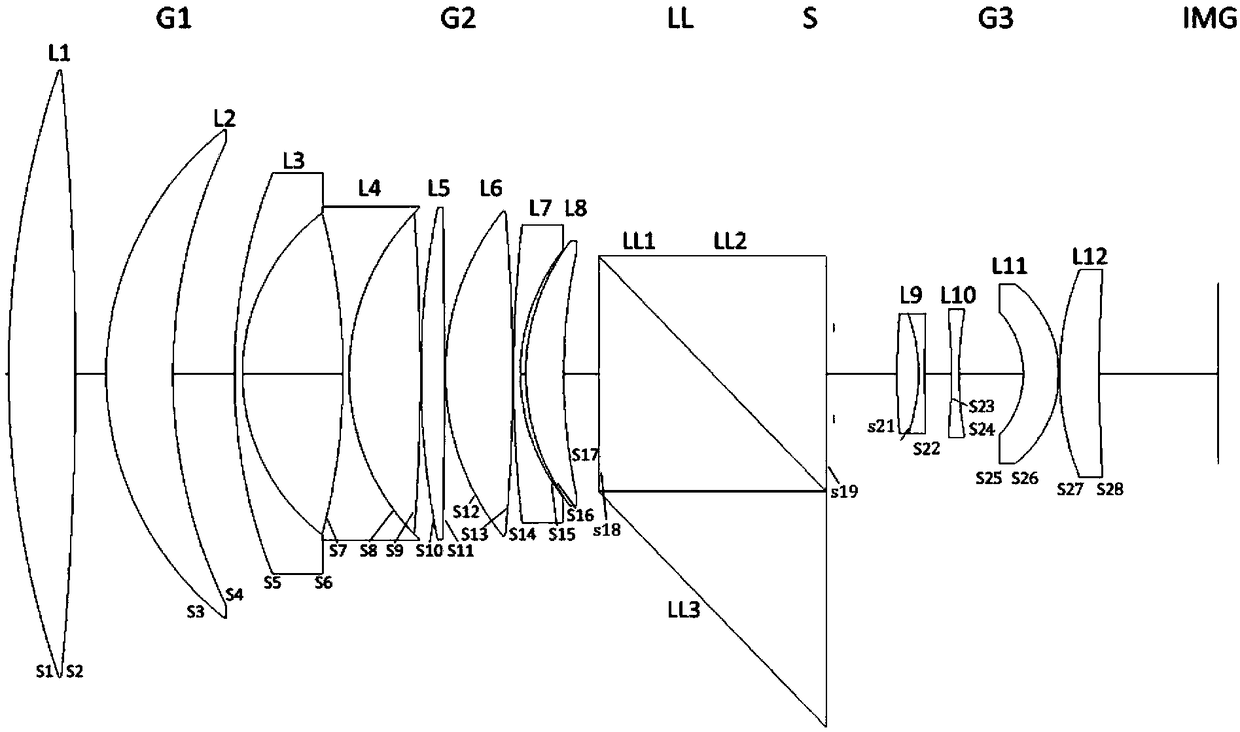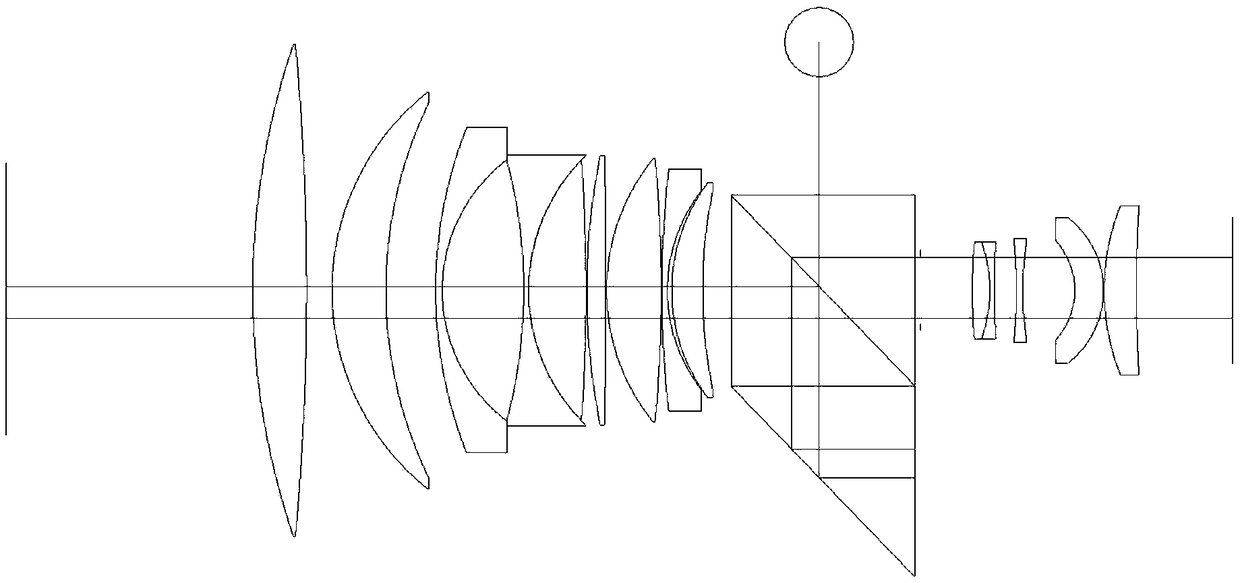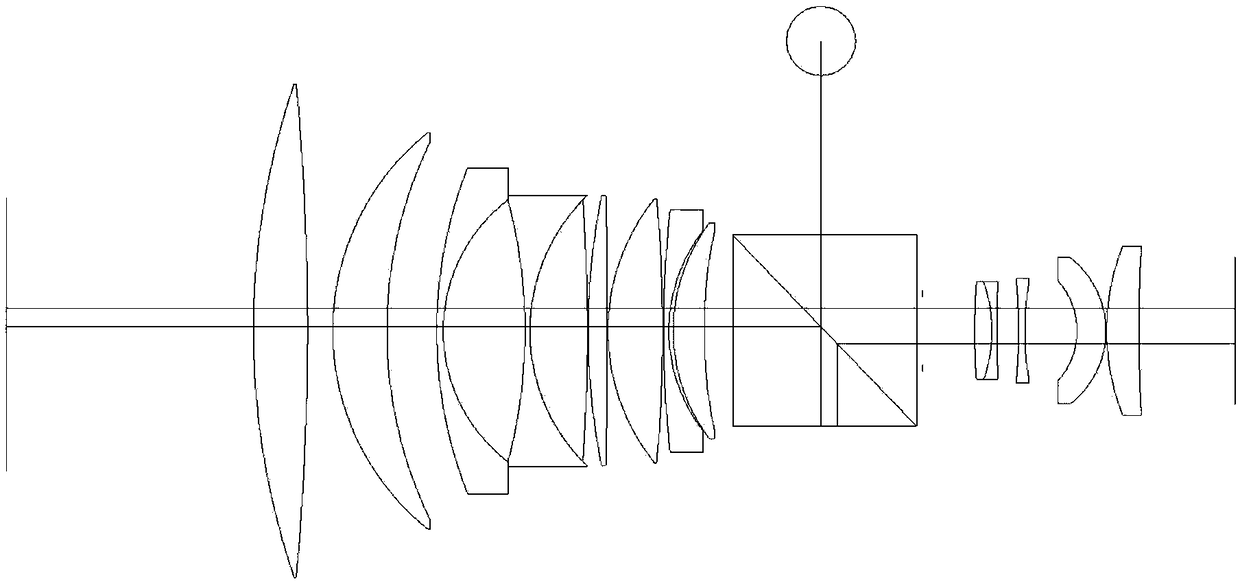Double-telecentric prime lens
A fixed-focus lens and double-telecentric technology, applied in the field of optical systems, can solve the problems of high-level telecentricity, low pixel resolution, and interference with lens imaging quality, etc., to achieve uniform brightness and clear image quality of imaging pictures Bright, clear and excellent imaging effect
- Summary
- Abstract
- Description
- Claims
- Application Information
AI Technical Summary
Problems solved by technology
Method used
Image
Examples
Embodiment 1
[0035] Such as figure 1 As shown, in this embodiment, the first lens group G1 with positive refractive power, the second lens group G2 with positive refractive power, the special-shaped reentrant prism LL, and the diaphragm are arranged in sequence from the object side to the image side along the light incident direction. STP, a third lens group G3 with positive refractive power, and an imaging surface IMG.
[0036] The first lens group includes: a first lens L1 with positive power, a second lens L2 with positive power, and an aspherical third lens L3 with negative power.
[0037] The second lens group includes: a fourth cemented lens L4 with negative refractive power and the cemented surface facing the image side, a fifth lens L5 with positive refractive power, a sixth lens L6 with positive refractive power, and a sixth lens L6 with negative optical power. The seventh lens L7 with positive refractive power, and the eighth lens L8 with positive refractive power.
[0038] The...
Embodiment 2
[0055] Such as Figure 4 Shown is a schematic diagram of the structure of this embodiment. Compared with Embodiment 1, the third lens L3 of the first lens group in this embodiment adopts a spherical lens with negative refractive power, and the eighth lens L8 of the second lens group adopts a positive refractive power and the glued surface faces the image. square eighth cemented lens.
[0056] Specifically, the telecentric fixed-focus lens described in this embodiment has an effective focal length of 275 mm and an object-image distance of 380 mm.
[0057] The lens structure parameters of the present embodiment are specifically as follows:
[0058]
[0059]
[0060] The absolute values of the ratios of the focal length of the first lens group, the second lens group, and the third lens group to the overall focal length of the lens in this embodiment satisfy 0.63, 0.67, and 0.52 in sequence. The reasonable focal length ratio of the lens group can balance the axial chrom...
Embodiment 3
[0067] Such as Figure 6 Shown is a schematic diagram of the structure of this embodiment. Compared with Embodiment 1, a thirteenth lens L13 with positive refractive power is further provided behind the twelfth lens L12 in the third lens group in this embodiment to increase the image-side telecentricity.
[0068] Specifically, the telecentric fixed-focus lens described in this embodiment has an effective focal length of 128 mm and an object-image distance of 380 mm.
[0069] The lens structure parameters of the present embodiment are specifically as follows:
[0070]
[0071]
[0072] The absolute values of the ratios of the focal length of the first lens group, the second lens group, and the third lens group to the overall focal length of the lens in this embodiment satisfy 0.72, 0.62, and 0.55 in sequence. The reasonable focal length ratio of the lens group can balance the axial chromatic aberration caused by imaging.
[0073] The object-space telecentricity and t...
PUM
 Login to View More
Login to View More Abstract
Description
Claims
Application Information
 Login to View More
Login to View More - R&D
- Intellectual Property
- Life Sciences
- Materials
- Tech Scout
- Unparalleled Data Quality
- Higher Quality Content
- 60% Fewer Hallucinations
Browse by: Latest US Patents, China's latest patents, Technical Efficacy Thesaurus, Application Domain, Technology Topic, Popular Technical Reports.
© 2025 PatSnap. All rights reserved.Legal|Privacy policy|Modern Slavery Act Transparency Statement|Sitemap|About US| Contact US: help@patsnap.com



